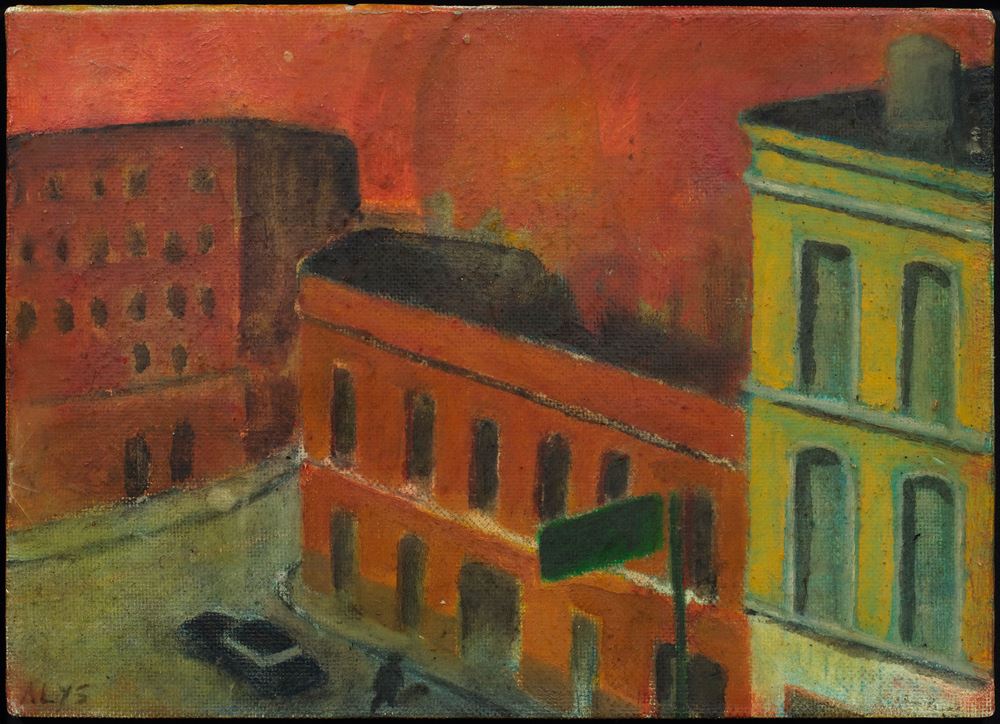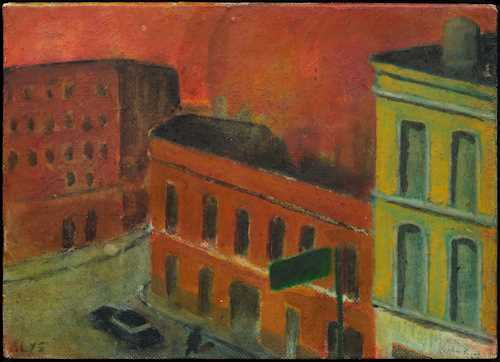
Lot 3463* - A201 PostWar & Contemporary - Thursday, 30. June 2022, 05.00 PM
FRANCIS ALŸS
(Antwerp 1959–lives and works in Mexico City)
Balderas. 1989.
Oil on board covered with canvas.
Signed lower left: ALYS.
13 × 18 cm.
Provenance:
- Galerie Yvon Lambert, Paris.
- Private collection.
- Phillips New York, Auction 29 May 2014, lot 61 (verso with the label).
- Christie's Paris, Auction 8 June 2018, lot 227 (verso with the label).
- Collection Switzerland.
“What I can't tell with a photo I will tell with a painting, and what I can't tell with a painting I will tell with a video or text sometimes, et cetera.” Francis Alÿs.
Francis Alÿs was born in Antwerp in 1959. He studied architecture and urban planning. In 1986 he moved to Mexico City. During his numerous walks through the capital, he observed and documented daily life in and around this metropolis. It was his encounters with the problems of urbanisation and social unrest that inspired him from 1990 onwards to become a visual artist. He uses the urban space, which he reproduces through performative actions. His media for this include painting, drawing, photography, and video. Public space becomes his material, and his own body, or that of other people, his instrument, which he captures in public spaces. Step by step, he appropriates the social and anthropological dimensions of his environment, almost in a documentary and analytical manner, often in the form of series of works. Over the years, Alÿs has extended his excursions to other urban spaces, documenting London, Jerusalem, Venice, or Havana.
Precise, relevant social and political allusions run through his entire oeuvre. At the same time, these themes are expressed in a poetic ambiguity through his artistic language, so that his oeuvre permanently questions the link between artistic, creative, and political intervention. Here we have two examples that illustrate this link very well.
One is a small-format painting from 1989 from his early work "Balderas" (Lot 3463). Today, the Avenida Balderas is a multi- lane, that is one of the most important traffic arteries in Mexico City. This north-south axis runs west of the old city centre. It was named after Lucas Balderas, a Mexican officer who died in the war against the North American invasion in 1847. This street is full of history, as it has been repeatedly destroyed and partially rebuilt, which means that it is now peppered with a wide variety of architectural phases. The empty street in the hazy, Hitchcockian red dusk radiates an eerie, ominous yet poetic calm.
The other work presented here, from 1994, is named after the city of Monterrey (Lot 3464), located in the north-east of Mexico and is the capital of the Mexican state of Nuevo León. It is one of the most important industrial centres in Latin America, processing raw material products such as steel, building materials and glass, among other things. This megacity is also known for its very high crime rate. Drug trafficking, illegal emigration to the USA, but above all corruption, violent crime and other problems are always on the agenda. The artist characteristically depicts the daily challenges of the region in this postcard format. A burning car in an isolated industrial or suburban area. At the forefront of the viewer's mind is the question of what triggered this scene — was it vandalism, theft, escape, or drug dealing that led to this outcome? But the eye is quickly led away from such a sensation. The glowing car adds warmth to the cold surroundings. The painting begins to tell its own poetic fable.
The artist himself describes his practice as "a kind of discursive exploration made up of episodes, metaphors or parables".
- Galerie Yvon Lambert, Paris.
- Private collection.
- Phillips New York, Auction 29 May 2014, lot 61 (verso with the label).
- Christie's Paris, Auction 8 June 2018, lot 227 (verso with the label).
- Collection Switzerland.
“What I can't tell with a photo I will tell with a painting, and what I can't tell with a painting I will tell with a video or text sometimes, et cetera.” Francis Alÿs.
Francis Alÿs was born in Antwerp in 1959. He studied architecture and urban planning. In 1986 he moved to Mexico City. During his numerous walks through the capital, he observed and documented daily life in and around this metropolis. It was his encounters with the problems of urbanisation and social unrest that inspired him from 1990 onwards to become a visual artist. He uses the urban space, which he reproduces through performative actions. His media for this include painting, drawing, photography, and video. Public space becomes his material, and his own body, or that of other people, his instrument, which he captures in public spaces. Step by step, he appropriates the social and anthropological dimensions of his environment, almost in a documentary and analytical manner, often in the form of series of works. Over the years, Alÿs has extended his excursions to other urban spaces, documenting London, Jerusalem, Venice, or Havana.
Precise, relevant social and political allusions run through his entire oeuvre. At the same time, these themes are expressed in a poetic ambiguity through his artistic language, so that his oeuvre permanently questions the link between artistic, creative, and political intervention. Here we have two examples that illustrate this link very well.
One is a small-format painting from 1989 from his early work "Balderas" (Lot 3463). Today, the Avenida Balderas is a multi- lane, that is one of the most important traffic arteries in Mexico City. This north-south axis runs west of the old city centre. It was named after Lucas Balderas, a Mexican officer who died in the war against the North American invasion in 1847. This street is full of history, as it has been repeatedly destroyed and partially rebuilt, which means that it is now peppered with a wide variety of architectural phases. The empty street in the hazy, Hitchcockian red dusk radiates an eerie, ominous yet poetic calm.
The other work presented here, from 1994, is named after the city of Monterrey (Lot 3464), located in the north-east of Mexico and is the capital of the Mexican state of Nuevo León. It is one of the most important industrial centres in Latin America, processing raw material products such as steel, building materials and glass, among other things. This megacity is also known for its very high crime rate. Drug trafficking, illegal emigration to the USA, but above all corruption, violent crime and other problems are always on the agenda. The artist characteristically depicts the daily challenges of the region in this postcard format. A burning car in an isolated industrial or suburban area. At the forefront of the viewer's mind is the question of what triggered this scene — was it vandalism, theft, escape, or drug dealing that led to this outcome? But the eye is quickly led away from such a sensation. The glowing car adds warmth to the cold surroundings. The painting begins to tell its own poetic fable.
The artist himself describes his practice as "a kind of discursive exploration made up of episodes, metaphors or parables".
CHF 14 000 / 18 000 | (€ 14 430 / 18 560)
Sold for CHF 33 240 (including buyer’s premium)
All information is subject to change.


